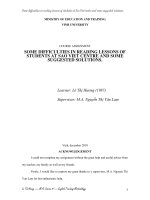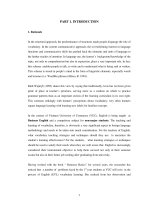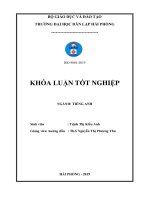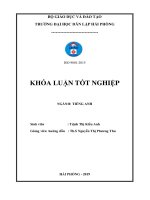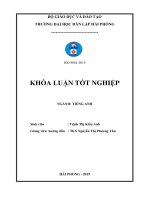Huflit students opinions of some suggested solutions for overcoming their public speaking anxiety graduation paper, major english study
Bạn đang xem bản rút gọn của tài liệu. Xem và tải ngay bản đầy đủ của tài liệu tại đây (1.01 MB, 54 trang )
MINISTRY OF EDUCATION AND TRAINING
HCMC UNIVERISTY OF FOREIGN LANGUAGES
AND INFORMATION TECHNOLOGY
DEPARTMENT OF FOREIGN LANGUAGES
GRADUATION PAPER
ASSESSING THE EFFECTIVENESS OF SOME SOLUTIONS
TO OVERCOME THE FEAR OF PUBLIC SPEAKING
SKILL FOR ENGLISH STUDENTS AT HO CHI MINH
UNIVERSITY OF FOREIGN LANGUAGES –
INFORMATION TECHNOLOGY
Instructor: Ms. Quan Vu Ngoc Lien (M.A)
Student: Nguyen Kim Tien
Student ID: 15DH710578
Major: English Study
Ho Chi Minh City, June 18th, 2019
TABLE OF CONTENT
Content
Page
DECLARATION ................................................................................................. iv
ACKNOWLEDGEMENT................................................................................... v
ABBREVIATION LIST ...................................................................................... vi
ABSTRACT ......................................................................................................... vii
1. INTRODUCTION ........................................................................................... 1
1.1 Background ............................................................................................... 1
1.2 HUFLITers’ Pubic Speaking Anxiety......................................................... 1
1.3 Objectives ................................................................................................. 1
1.4 Organization ............................................................................................. 2
1.5 The research question(s) ........................................................................... 2
2. LITERATURE REVIEW ............................................................................... 3
2.1 The definition of Public Speaking Skill ...................................................... 3
2.2 The importance of Public Speaking Skill ................................................... 3
2.3 The theory and different symptoms of Public Speaking Anxiety .................. 4
2.4 Some possible reasons ............................................................................... 5
2.5 Some suggested solutions ........................................................................... 6
3. METHODS ...................................................................................................... 8
3.1 Overview ................................................................................................... 8
3.2 Description of the Subjects & Setting ......................................................... 8
3.3 Procedures of Data Collection................................................................... 8
3.4 Statistical Treatment .................................................................................. 10
4. RESULTS ........................................................................................................ 11
4.1 The groups of age of learners participating in PS in the total
of three classes ................................................................................................ 11
4.2 The gender of learners in the total three PS classes ................................... 12
ii
4.3 The learners’ attitude towards PS .............................................................. 13
4.4 The reason why learners studied PS .......................................................... 14
4.5 Whether students find it difficult to give a speech due to fear or
not ................................................................................................................... 15
4.6 The learners’ attitudes towards minimizing PSA by using some
useful strategies and seeking some professional help ...................................... 16
4.7 The most effective strategies for reducing PSA selected by
students ........................................................................................................... 17
4.8 Students’ comments on the effectiveness of applying the chosen
ways ................................................................................................................ 19
5. DISCUSSION .................................................................................................. 24
6. CONCLUSION AND RECOMMENDATION .............................................. 33
6.1 Purpose of the Study .................................................................................. 33
6.2 Findings and Explanation .......................................................................... 33
6.3 Limitations................................................................................................. 34
6.4 Recommendations ...................................................................................... 35
Appendix ............................................................................................................... 41
References ............................................................................................................. 45
iii
ACKNOWLEDGEMENT
The research would not been possible to complete without receiving support,
assistance, instruction and contributions of these special people. The researcher would
like to take this opportunity to express the appreciation to the following:
Department of Foreign Languages, HCMC University of Foreign Languages
and Information Technology for allowing this research to be recognized.
Ms. Quan Vu Ngoc Lien (M.A), who is an English teacher at HUFLIT and
instructor of this research, provided valuable advice, feedback, tips, untiring assistance,
direction, encouragement, perceptive comments, suggestions, professional guidance,
support, and ideas to finish this research completely.
HUFLIT’ students, who have taken part in this research as conducting the
research questionnaire with the prominent contribution and assistance.
Mr. Tran Thanh Tu (M.A), whose significant support and guidance have aided
and facilitated the process of forming this research.
Friends and family, for great spiritual support and encouragement throughout
this research.
iv
DECLARATION
I declare that this assignment is original and has not been submitted for
assessment elsewhere.
I declare that this assignment is my own work and does not involve plagiarism
or collusion.
No other’s work or ideas have been used without acknowledgement, except I
clearly state that I have used from elsewhere
v
ABBREVIATION LIST
In this research, several long terms were used. However, to avoid repetition of
words, there will be abbreviations for these terms:
1. HUFLIT: HCMC University of Foreign Languages and Information Technology
2. PS: Public Speaking
3. PSA: Public Speaking Anxiety
4. EFL: English as Foreign Language
vi
ABSTRACT
Public speaking (PS) is considered as one of most important skills at school and
work through many generations, but the speech anxiety is still a problem that students
in numerous schools have, especially those who are learning foreign languages. The
objective of this study was to investigate and suggest some possible useful strategies
for English major students at HUFLIT to reduce the fear of PS in foreign language
setting. There were many ways to overcome this fear. However, in this paper, the most
useful methods would be chosen and voted by 2nd year student. Additionally, there
would be a survey to figure out how many people considered this problem truly
depressing. The researcher implemented quantitative methods (questionnaire) on 73
sophomores studying at Ho Chi Minh University of Foreign Language - Information
Technology (HUFLIT) in District 10, Ho Chi Minh City. They were 59 female and 14
male students aged between 20 and 22 at the time that the survey was conducted in the
academic 2018-2019. Research revealed that 78.1% of participants admitted they were
terrified of public speaking during their PS courses. Likewise, almost 100% of
participants indicated they found practicing the speeches several times before giving it
in front of audience was the most plausible solution for them to be more and more selfassured. Moreover, with the ways consisting of doing exercise (take a deep breathing),
watching recordings to detect the errors, or having a backup (note card, cue card) were
also assessed highly at about 97%, 96%, and 95% respectively for English major
students to defeat public speaking apprehension and possible to face audience
irrespective of the quantity of people in performing a presentation.
Keywords: anxiety, confidence, fear, public speaking
vii
Chapter 1: INTRODUCTION
1.1 Background:
Today, it is known that PS skill is one of the essential skills for many university
and college students due to its benefits not only during the time they are studying but
also in their long careers. Therefore, many universities and colleges including HUFLIT
have applied this subject into their education and training system. However, almost all
students always find it difficult to acquire skills for delivering a good speech; thus,
they suffer the nervous status.
1.2 HUFLITers’ Pubic Speaking Anxiety:
PSA is a common psychological apprehension for university students that
affects to learners' ability of emotional expression, especially for English major
students at HUFLIT. Although many studies have been done on a large number of
ways suggested to help them solve this problem and improve their PS skills in
universities and colleges, there has been no studies made at HUFLIT until now and
almost students still feel some degree of anxiety before giving a presentation because
most of HUFLITers have to use the foreign language like English to present in their
workshops. As a result, students often avoid performing a presentation or activities
relating to PS in front of a crowd of people. Hence, in this study, the researcher
demonstrated to clarify that PS is truly a terrifying and horrible matter for students
including English major students as well as paid more attention to the aspects that may
be important to help HUFLIT’ students in their PS skills by introducing them some
effective strategies, so they can gain a lot of experience and confidence.
1.3 Objectives:
The purpose of this study was to focus on analyzing as well as providing some
several ways of reducing high levels of PSA for students at HUFLIT. Moreover, how
students' attitudes and thoughts towards suggested solutions for improving their
[1]
confidence when making presentations in EFL classes were also considered. The
expressions of agreement in each method were compared while their attitudes and
thoughts were employed to support the methods supplementarily.
1.4 Organization:
A scientific report will be structured in six sections. The first section will be an
overview introduction about PS and the aim of the study. The structure of the report
will also be presented in section 1. In section 2, foreign literature will be reviewed
including its significance and the signs of PS fear followed by some further ideas that
were stated by previous researchers for improving students’ PS skills. Literature
review will provide the base to formulate the research methodology in section 3. In
section 4, the results will be presented, and some effective ways of how to overcome
PSA will be pointed out in section 5. Finally, conclusion and recommendations will be
proposed in the terminal section.
1.5 The research question(s):
The following questions will be analyzed to achieve mentioned objectives:
1. Whether English major students of HUFLIT find it difficult to give a speech due to
fear or not?
2. What are the most effective strategies/ the approaches for reducing public speaking
anxiety selected by students?
[2]
Chapter 2: LITERATURE REVIEW
This chapter is written for a better understanding of the definition of PS and
what learners get from learning PS skills, particularly in this survey, the theory of PSA
and some symptoms of that fear in colleges and universities. Moreover, some possible
causes of PSA are also mentioned to define the brief solutions of previous studies that
may be used to deal with anxiety when learning PS.
1. The definition of Public Speaking Skill:
PS skill (also known as oration) is the process or action of delivering a speech
directly to an audience with clarity and confidence for information conveyance. The
objective of the discourse may be to teach, engage, or impact the audience. The
speaker performs in front of a group of people that he/she knows (for example, in a
family celebration) or a completely alien crowd. Laura Spencer (2018) defined that it
is fundamentally an introduction that is given live in front of the group of audience. PS
can cover a wide assortment of diverse subjects. Speakers in PS regularly utilize visual
aids in the form of an electronic slideshow to supplement the discourse and make the
audience more curious.
2. The importance of Public Speaking Skill:
Over the years, the importance of PS is widely diversified in human daily lives.
When people can speak well in public, they can absolutely promote their careers,
develop their business and form some strong cooperation. Many areas of life often
require PS skills such as guidance or sales experts. Even for jobs that do not involve
PS skills in job descriptions, candidates will be eye-catching, more highly appreciated,
and make a better impression on many employers if they possess this skill. Garside
(2002) demonstrated the importance of learning PS skills for students for specific
reasons. Firstly, during the time of the process of preparing the presentation, students
do not only gain knowledge but also increase their confidence when presenting.
Confidence always makes the candidates stand out from others and gives them a
[3]
favorable opportunity to advance in their careers. Moreover, having good PS skills,
people can always convey their ideas or thoughts in the clearest and most effective
way. It is a great chance for people to prove their knowledge as an expert in their field
of work. Finally, the more people get promoted in their work, the more employees they
need to lead, so the demand for PS skills and its confidence is increasing because many
leaders at a high level need to pass on their opinions and motivate people to act on
their ideas. Being able to speak well in public can be a good element to help them
assert themselves for promotion. Indeed, Hackman and Johnson (2004) claimed that
impressive PS skills are necessary for all leaders.
3. The theory and different symptoms of Public Speaking Anxiety:
What is PSA? PSA (also called Glossophobia) is defined as a state of
nervousness, discomfort, fear, terror or fright about a situation that speaker must
communicate with or deliver a speech to the others in public caused by the feelings of
insecurity or not controlling the situations. The person having the high level of PSA
often avoids oral communication or performance situations, so these situations make
them distressed and upset. It is described as the number one fear of people, especially
among university students. Spijck (2011) implied that according to his research:
“Almost eighty out of every hundred people experienced PSA at a small or large scale.
Each four out of ten individuals ranked PS fear as one of their pinnacle three fears,
regularly a fear more ghastly than demise, divorce and unemployment”.
In order to get a better understanding of what anxiety is, Kelly (2002, p.54) also
described anxiety or fear as “a general feeling of apprehension including hypervigilance, increased sympathetic nervous system activity and difficulty concentrating”.
People having PS concern can be seen easily through many different symptoms of PSA
including palpitations, sweating, gastrointestinal discomfort, diarrhea, muscle tension,
and confusion (North & Rives, 2001). In addition, Craig N. Sawchuk, Ph.D., L.P
reported that:
[4]
PSA is a common form of apprehension. It can extend from slight
anxiety to paralyze fear and freeze. Numerous individuals with
this fear avoid PS situations altogether, or they endure them with
shaking hands and a brittle voice.
Before, during or after a speech, it is very common for people that have one or
all of following physical reactions: panic, nervousness, increased heartbeat, shaking,
upset stomach, shortness of breath, blushing, dry mouth, and excessive perspiration
(Markway, Carmin, Pollard, & Flynn, 1992).
4. Some possible reasons:
In order to find out the reasons behind this fear, Beatty (1988), Beatty and
Frieland (1990) created questionnaires to seek the main reasons. The results of the
questionnaires from his survey for most English major students having the fear of PS
came from numerous sources such as the lack of practice, and confidence, the feeling
of insecurity when being teased by other people for making mistakes, the shortage of
language proficiency, and so on. According to Price (1991), particularly from his
questionnaire, all subjects also confirmed that they were afraid of speaking foreign
language in front of many other students. Another reason of speech anxiety that Seim,
R. W., Waller, S. A., and Spates C. R. (2010) pointed out in their test results is giving a
speech with a completely unfamiliarity. Besides, the missing of preparation also makes
students feel inconfident during the speech. If there is not enough preparation or
material for the presentation, the speaker will easily get stuck and forget the content
because he/she does not have an overview of the topic. In addition, being unable to
cope with unexpected situations is another culprit of PS anxiety. PSA is also seen in
those with proficient foreign language skills because one of students may lack skills to
express their ideas impressively and have a feeling of anxiety or discomfort (Bippus,
AM, & Daly, JA, 1999). In order to get a clearer overview of all reasons of PSA which
influences negatively students in foreign language classes, (Zdena, K & Gabriela, P,
2017) investigated the sources of foreign language speaking anxiety of 154 Iranian
[5]
EFL learners by requiring them to fill in a PSA questionnaire which was developed
based on the Foreign Language Classroom Anxiety Scale (FLCAS) by Horwitz E. K.,
Horwitz M. B., and Cope (1986). They showed the results from their research with
several sources, but the main significant reasons of speech anxiety causing students’
anxiety were “the fear of making mistakes” (81%), “the fear of negative evaluation”
(78%), and “the lack of vocabulary knowledge” (72%). Indeed, Yahya (2013) carried
out a similar survey that implied “fear of negative evaluation” was one of the most
prominent causes of PS apprehension. Moreover, Lui (2006: 23-25) examined the root
of PS fear from 98 EFL language students and the findings stated that there was a large
number of different sources that caused anxiety for them during their PS courses
including the lack of practice and preparation, the limitation of vocabulary, the
insufficiency of grammar knowledge, the fear of making mistakes, the fright of
negative evaluation, the low level of proficiency, short-term memory, the obsession of
being the focus of attention, the inability to express ideas, poor pronunciation,
personality, shyness, the fear of being ridiculed, the unfamiliarity with topics,
environment and audience.
5. Some suggested solutions:
In general, the fear of giving a public speech can come from many causes. They
can lead to the consequence that more and more students try to avoid some specialized
courses that require oral presentations. People can even decide to choose a job they do
not love or skip the promotion just because they are frightened of speaking in the
public or often have to deliver a presentation in front of a group of people (Mark, B &
Mandy, G, 2018). Therefore, many researchers have taken this issue into consideration
to discover some effective strategies to overcome PSA. In order to figure out suitable
measures, Bippus, A. M., and Daly, J. A. (1999) studied the main causes of the fear of
PS, then many plausible methods to cope with this fear. Among them, one of the best
[6]
ways to improve PS skills was practicing because the lack of preparation and
perseverance is the main reason for stress in PS. If the speakers prepare their speech
thoroughly, they will be more confident to be able to clearly visualize their topics and
contents. Besides, Gutgold, N. D., and Grodziak, E. M. (2013) proposed another way
to control the tension when speaking in public which was using smart phones to record
assignments at home, and then detecting and correcting mistakes in the speech for
better performances. This method has been used for decades to help students review
their speech as a speaker. To define the strategy to overcome the fear of PS better,
Adams, S. (2012) pointed out the importance of understanding the documents and the
audience. In the similar way, worrying about PS is common, especially when people
know very little about their topics and audience. PS worries have a close relationship
with the uncertainty about audience and subject matter. Moreover, practicing speech in
front of the mirror is also a beneficial way to improve speaking skills. According to
Adams, S. (2012), some standard advice could be used to overcome anxiety when
talking, namely, selecting familiar materials or focusing on a friendly face to create a
feeling of comfort. By the same token, speakers could also try some relaxing exercises
such as deep breathing that can help reduce anxiety. From the research of Raja, F.
(2017), he revealed that providing proper counseling, instruction and coaching could
help students enable to face with the PSA. He advised that teachers should use games
and enjoyable activities to create a relaxing atmosphere in order to promote PS skills
and generate the security for speaking in English within a cooperative environment.
Moreover, Ron, K. (2001) suggested that it is necessary for students to have a speech
outline on some small sheets of papers that can decrease the anxiety of being afraid of
forgetting what they are going to say or having their minds in blank.
[7]
Chapter 3: METHODS
3.1 Overview:
For accurate results, the researcher looked at many factors affecting data during
the collection process. The second-year major English students of HUFLIT's
Department of Foreign Languages were selected as the research subjects with a total of
73 students out of three classes. This research was conducted in the second semester of
the second year because learners had to learn to speak in public during this period.
After the study, the researcher could also rely on their ideas to carry out this research
to help learners find ways to improve their PS skills.
3.2 Description of the Subjects& Setting:
The subject for this study consisted of 73 participants who were students at the
second level majoring in English language from Department of Foreign Language at
HUFLIT in the academic year 2018-2019. All of the students were sophomore and
spoke Vietnamese as their mother tongue. They were aged between 20 and 22 at the
time of this study. They participated in the survey by answering all questions of the
questionnaire about their experience and opinions on overcoming PSA.
3.3 Procedures of Data Collection:
This was a small-scale exploration study conducted to analyze the needs of PS
class students at the university level to build strategies to overcome PSA. Research
was done by quantitative descriptive research method. The researcher developed the
questionnaire that based on reviewing the relevant literature and observing the
previous researches. Creswell (1994) defined that quantitative research as the
interpretation of phenomena by collecting numerical data analyzed by mathematicalbased methods. The method that was used to conduct the study included a
questionnaire as the main data collection tool. Using self-administered questionnaire
distributed to 73 university students collected data.
[8]
To compare the effectiveness of other methods to overcome the fear of PS,
quantitative data in Google forms app allows participants to comment on the
effectiveness of different ways to reduce anxiety. Quantitative data was collected
through close-ended and open-ended question items close to the assessment with the
format. In the second semester, English students studied PS 1 at school, and then,
students were given an online questionnaire comprising of eight emotional
measurement questions called Personal Report of Public Speaking Anxiety (PRPSA)
related to PS. Respondents were required to indicate to which those ideas can be
applied to them by marking whether they Strongly Agree, Agree, Disagree, Strongly
Disagree with each statement or not. The open-ended question was given to learners at
the end of questionnaire to explore their perspectives on the advantages of selected
solutions. The answers about their opinions and experience in this question were
recorded to clarify ways of anxiety reduction that helped the researcher to collect
information in detail. The questionnaire was completed without any personal
identification to ensure anonymity and increase the probability of honest answers. In
addition, the survey results were collected on a percentage basis and compared
between each answer to know each learner's perspective on the effectiveness of
applying each method in PS. The survey was conducted online via e-mail and took 510 minutes to complete. Participants had a week to finish the questionnaire to the
researcher.
The designed questionnaire for English major students concluded items with
three primary contents:
• Item 1, 2 showed the information of learners participating to answer the
questionnaire
• Item 3, 4, 5 indicated the learners’ attitudes and reasons towards studying PS
skills
[9]
• Item 6, 7, 8 referred to the learners’ attitudes towards applying useful strategies
for minimizing the PSA
3.4 Statistical Treatment:
To evaluate the effectiveness of several methods, it is necessary to analyze
which ones are more preferable. Additionally, through the Google Form Application
and Microsoft Excel data analysis tool package, statistics were collected and analyzed
to display results.
[10]
Chapter 4: RESULTS
The questionnaire includes eight questions written in English, and it needed to
be responded based on the readers’ views. The researcher delivered online
questionnaire to the participants of three classes through the groups on Facebook and
all copies were gathered. The researcher was able to obtain lots of information on the
attitudes of learners in learning PS skills as well as the solutions for learners. The
statistical analysis and the result of data analysis were shown clearly in the following
charts.
4.1 The groups of age of learners participating in PS in the total of three
classes:
Pie chart 4.1: The groups of age of learners participating in PS in the total
of three classes
4%
1%
20 years old
21 years old
22 years old
95%
The pie chart 4.1 summarizes the quantity of students attending three PS classes
in the second semester during the period of four months from February to June in
2019. There were 69 learners (95%), who were 20 years old, studied in PS courses. It
[11]
is noticeable that they were sophomores, who were studying PS 1, which was the
obligatory subject in this semester. It can be also concluded from the pie chart that the
small group of age of 21-22 years old at 4% and 1% correspondingly had PS lessons.
4.2 The gender of learners in the total three PS classes:
Pie chart 4.2: The gender of learners in the total three PS classes
19%
Male
Female
81%
The pie chart 4.2 shows data about the amount of male and female learners took
part in three PS classes. There were nearly three times as many female as male in PS
courses that made the number of women participants much higher than men with 59 of
female learners (81%), compared to 14 of male learners (19%).
[12]
4.3 The learners’ attitude towards PS:
Pie chart 4.3: The learners’ attitude towards PS
3%
39%
58%
Interesting
Useful and helpful
Difficult and boring
The pie chart 4.3 examines the learners’ interests in learning PS at HUFLIT. As
is observed from the chart, more than a half of learners (58%) felt interested in
learning PS even though this subject not only required students to be confident but also
acquire many PS skills. On the other hand, the number of learners who asserted that
studying PS was both helpful and useful made up 39%. Surprisingly, the percentage of
students who felt not only difficult but also bored when learning PS was a very small
number of 3%.
[13]
4.4 The reasons why learners studied PS:
Pie chart 4.4: The reasons why learners studied PS
9%
33%
46%
12%
Compulsion
Excitement
Benefits
PS skill improvement
The graph 4.4 illustrates the reasons for studying PS of the participants. It is
clear that the proportions of these students who were constrained to learn PS as a
compulsory subject in the course, accounting for nearly a half (46%) of the total. By
contrast, the number of learners studying PS due to its excitement and benefits was not
small with 12% and 33% respectively. Especially, there were just 9% of participants
wishing to learn more skills for their study.
[14]
4.5 Whether students find it difficult to give a speech due to fear or not:
Pie chart 4.5: Whether students find it difficult to give a speech due to fear
or not
21.9 %
Yes
No
78.1 %
The pie chart 4.5 compares the number of students in HUFLIT if they expressed
agreement or disagreement with the finding that PS is hard to present in front of the
crowd because of suffering PSA. Overall, it can be seen that in general, there was a
dominant percentage of HUFLIT learners who had experienced PSA in their classes,
and it rose up to 78.1% from the data collected in the survey. It appears that almost
every major students of HUFLIT always felt frightened and nervous before, during or
after they give a presentation. That leads to the option ‘YES’ (agree) as a larger
proportion, accounting for 78.1 % of the total approximately 57 out of 73 students
while the rest felt confident (21.9%).
[15]
4.6 The learners’ attitudes towards minimizing PSA by using some useful
strategies and seeking some professional help:
Pie chart 4.6 The learners’ attitudes towards minimizing PSA by using
some useful strategies and seeking some professional help
NEUTRAL
11%
NEGATIVE
3%
POSITIVE
86%
The pie chart 4.6 shows the percentages of three different attitudes of 73
learners towards improving their speeches in PS courses. The number of learners with
positive attitudes is rather high comparing to the ones with negative and neutral
learning manner. In another words, these numbers do not exceed the researcher’s
expectation. It is clear to see that the quantity of learners who have positive attitude
greatly dominated the others with 86%.
[16]
4.7 The most effective strategies for reducing PSA selected by students:
Table 4.7: The most effective strategies for reducing PSA selected by
students
Methods
Strongly
Agree
Disagree
Agree
Strongly
Disagree
Practice your
62
11
0
0
speech before
(85%)
(15%)
(0%)
(0%)
Have a backup,
27
42
4
0
in case you
(37%)
(58%)
(5%)
(0%)
Watch
23
47
3
0
recordings of
(32%)
(64%)
(4%)
(0%)
Give your
18
38
14
3
speech to
(25%)
(52%)
(19%)
(4%)
Lightly exercise
31
40
2
0
before speaking
(42%)
(55%)
(3%)
(0%)
Focus on a
17
35
18
3
friendly face
(23%)
(48%)
(25%)
(4%)
you give it
forget what you
want to say
your speeches to
detect errors
another person
(do some deep
breathing)
(good
[17]
interaction)
Choose a topic
30
33
10
0
that you know
(41%)
(45%)
(14%)
(0%)
Talk to yourself
35
33
4
1
in front of the
(48%)
(45%)
(5%)
(1%)
Focus on the
5
27
34
7
material, not the
(7%)
(37%)
(47%)
(10%)
Participate in
18
44
9
2
public speaking
(25%)
(60%)
(12%)
(3%)
Have lecturers’
50
23
0
0
help
(68%)
(32%)
(0%)
(0%)
well
mirror
audience
activities/
English clubs
(7sec)
The table 4.7 shows among ten ways for reducing depression, practicing the
speech accounts for 85% (65 students) strongly agreed and 15% (11 students) agreed
out of the total. The figure for receiving teachers’ help tends to be fairly similar to
practicing the speech with 73 students (100%) agreed of the total number, but its
amount of strong agreement is slightly smaller in terms of practicing. Noticeably,
doing a light exercise, watching recordings, and having a backup are the next most
significant solutions that participants gave the approval with a prominent proportion of
[18]
